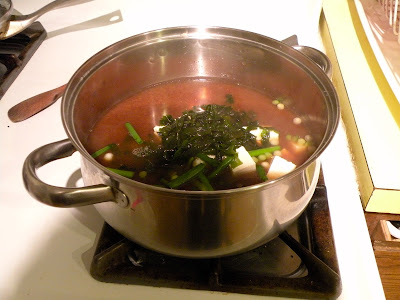I love the holidays, especially the part about hanging out with friends and family, but even the best Christmas is something of an ordeal, and tonight we Lovesmith's are a bedraggled bunch, worse for wear from
travel, sleep deprivation, head colds, and days of
eating food we don’t usually eat. Some of us are also feeling the effects of those extra swigs of whiskey.
It’s the perfect night for a miso soup dinner. Miso soup
does all kinds of magical things; it detoxifies and alkalizes the
blood, soothes digestion, stimulates the immune system and in general straightens a body right out. You can read about its health benefits all over the place, including here and here.
I have been making miso soup for years, ever since a six-month stint living at the Kushi Institute, a macrobiotic community and
study center (more on this in future posts), but it’s always turned
out meh, at best. Henry and I decided that
our next stretch of cooking lessons will focus on soup-making, and we agreed that the first
order of business was to develop an excellent miso soup recipe. We imagined a
series of test kitchen experiments, pot after pot of soup until we got
it just right.
But before we even began, my friend Josh gave me his vegetarian adaptation of his Japanese grandmother’s miso
soup recipe. When somebody gives you his grandmother’s recipe for something,
rejoice. Rest assured, you're in for something good.
I made Josh’s soup for my family and it was an immediate hit. Jonah, home for the holidays from the University of Illinois, gave it his supreme compliment: “This
tastes like restaurant miso soup!” And
so ended our very, very short search for the perfect recipe, and even better –
Josh gave me permission to share it with the world.
Miso Soup
4 servings
1 piece dried kombu *
4 dried shiitake mushrooms
1 handful dried wakame *
2 scallions, green parts sliced into 2-inch pieces, white parts slivered
1 package firm tofu, cubed.
4 tablespoons miso (Josh uses a combination of white and red miso, and I did the same - I think that using two different types of miso is part of what makes this soup so full-bodied).
* kombu and wakame are seaweed, readily available in health food stores and Asian markets

All the best for a happy, healthy new year!
4 servings
1 piece dried kombu *
4 dried shiitake mushrooms
1 handful dried wakame *
2 scallions, green parts sliced into 2-inch pieces, white parts slivered
1 package firm tofu, cubed.
4 tablespoons miso (Josh uses a combination of white and red miso, and I did the same - I think that using two different types of miso is part of what makes this soup so full-bodied).
* kombu and wakame are seaweed, readily available in health food stores and Asian markets
Put kombu, shiitake mushrooms, and 6 cups of water in a pot.
Bring to a boil and simmer 25 minutes.
While the broth is simmering, chop tofu and scallions.
Soak wakame in water to rehydrate.
Measure miso into a bowl or cup.
Scoop out a little hot broth and add to miso. Stir well with a fork to blend into a smooth mixture.
After broth has simmered 25 minutes, remove kombu and shiitakes from stock.
Save for another use or discard.
Save for another use or discard.
Pour soaking water off wakame and chop into small pieces.
Add wakame to simmering broth along with dissolved miso, scallions, and tofu.
Cook at a low simmer (you don't want to vigorously boil miso) for five minutes.
Josh recommends serving with a side of white rice. I agree wholeheartedly.
Add a bowl of steamed veggies to make a complete meal, light but thoroughly satisfying.
And if my family's response is any indication, people adore meals composed of food in little bowls.
All the best for a happy, healthy new year!

